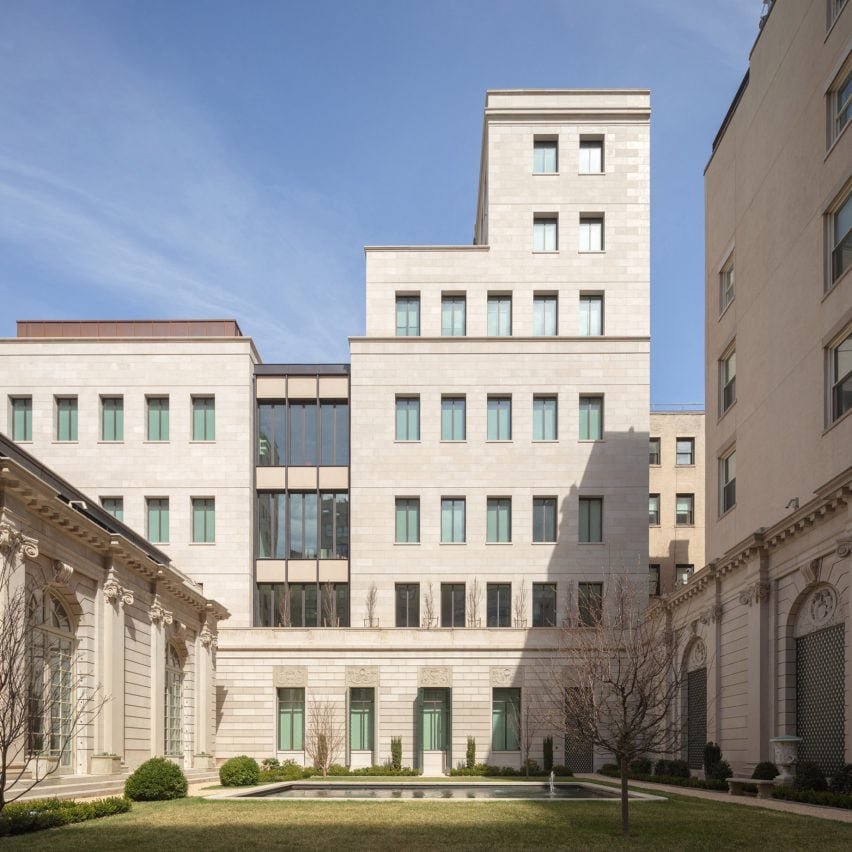New York-based Selldorf Architects has unveiled the renovation and expansion of a historic Upper East Side mansion that houses The Frick Collection of art.
Designed by Selldorf Architects with Beyer Blinder Belle as executive architects, the project involved the addition of 2,500 square metres (27,000 square feet) of new construction and 5,574 square metres (60,000 square feet) of repurposed space within the museum.

The beaux-arts home on Fifth Avenue – built in 1914 for industrialist Henry Clay Frick – also received new galleries and amenities, improved ADA access, while its beloved Russell Page-designed 70th Street Garden was also restored.
“The design harmoniously integrate the Frick’s historic architecture with new additions, creating spaces that will allow the institution to more thoroughly carry out its mission and serve 21st-century audiences,” said Selldorf Architects, whose founder Anabelle Selldorf was recently named on the Time 100 list of most influential people for 2025.

The newly constructed architectural interventions were focused around four major areas, including the rear facade of the Frick Art Research Library, which was rebuilt and extended 6.7 metres (22 feet) south.
A two-storey overbuild forms an addition in the centre of the building that houses the new special exhibition galleries, with offices and a conservation studio above.

The roof of the Reception Hall was raised by 2.1 metres (7 feet), and its new second storey is aligned to enable direct access to the collection galleries within the historic house.
Finally, a space was excavated below the 70th Street Garden to make room for a new 218-seat auditorium for lectures, music and performances.

“This space has an enveloping curvilinear form that creates a sense of intimacy between the audience and the presenters and contributes to its superb acoustic quality,” said Selldorf Architects.
For the additions, the same Indiana limestone was used in matching block patterns to the historic buildings, including the original house by Carrère and Hastings, and the 1935 expansion by John Russell Pope.

A transparent bronze-and-glass “bridge” element where the mansion meets the library also “serves to break down the overall volume while bringing views of the garden and light to the interior,” according to Selldorf Architects.
Visitors will continue to arrive on East 70th Street, where a ramp has been added to make the main museum entrance ADA compliant for the first time.

The enlarged Reception Hall offers direct access to the museum’s original galleries on its main floor, while the second-floor galleries, museum shop and cafe can be reached via new elevators.
The second floor can also be accessed from the main-floor galleries via the building’s original grand staircase.
“The entire project is executed with sensitivity and restraint that unequivocally expands the Frick by complementing, respecting, and enhancing its unique architectural legacy,” Selldorf Architects said.
The plans to overhaul The Frick Collection were not without controversy: protests took place when the proposal was unveiled in 2018.

An earlier proposal to expand and update the museum, by Davis Brody Bond, also drew criticism in 2015 and was later abandoned.
On both occasions, preservationists were unhappy about how the plans treated Page’s viewing garden, completed in 1977.

However, critics have largely been positive about Selldorf Architects’ enhancements to the site since they were officially unveiled last month.
The firm’s other cultural projects that are currently underway include the expansion of the Art Gallery of Ontario and the revamp of the Sainsbury Wing at the National Gallery in London — which has also ruffled feathers.
The photography is by Nicholas Venezia, unless stated otherwise.
The post Selldorf Architects completes The Frick Collection renovation in New York appeared first on Dezeen.

